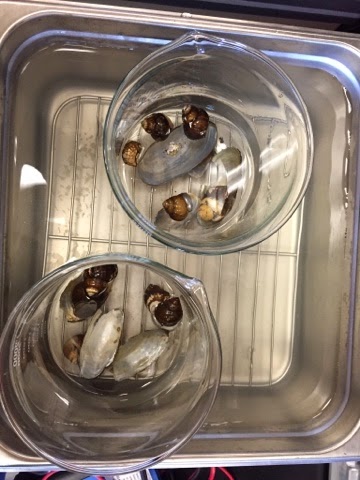So there is a good chance that as I post more about the work that I am doing this summer, there may be a lot of references to something called a 'butter shale' or 'trilobite shale'. So here I want to explain those terms a little bit to put things in context.
Butter shales are blue-green, clay rich deposits that we find throughout the Katian strata along the Cincinnati Arch. These deposits tend to be a couple meters thick, show conchoidal fracturing and not much obvious bedding in outcrop.
 |
| Image of the Treptoceras duseri butter shale from Indiana |
There are two schools of thought as to how these shales derived their names. The first school of thought (and the one I tend to go with) is that they get their names from the fact that when the shales are wet, they turn into soft mud that you could cut with a butter knife. Just last year I was digging through one of Waynesville Fm butter shales and both my feet got stuck in the wet mud. I had to have an undergrad student who was with me at the time, dig me out while perching himself on a limestone float block! The second school of thought is that the name is derived from the buttery yellow coloration some of these shales show when very weathered. Reality it is probably a combination of both, but if any of our readers out there have some insight be sure to leave us a comment below!
(I tried to image this butter knife in shale bit but every time I stuck the knife into the shale that I had soaked in water it slice all the way through....so case in point I suppose!)
Now all these properties are interesting, but why do people care about these shales? Here is where the second name 'trilobite shale' comes into play. These shales heavily sought after because they generally contained well articulated trilobites (
Isotelus, Flexicalymene, Amphilichas, etc) along with articulated bivalves, wonderful
lingulids and other assorted critters. Now not all the shales that look like butter shales have these fossils in them, and even the ones that do require lots of work to find and properly collect the fossils, but the results are glorious!
These fossils are thought to have been preserved through rapid burial of fine grained sediment during storm events, essentially smothering the local fauna. Some of these deposits have been trace over 100km showing that these were widespread events!
 |
| Image of a Flexicalymene peaking out from the Treptoceras duseri butter shale in Indiana |
 |
| Image of a large lingulid brachiopod that are common in the butter shales |
Finding the fossils is always an exciting process, but recently I have become interested in what makes these shales different from "normal shales" or shales that don't show these same buttery characteristics. To that end, I have applied for a
Clay Mineralogical Society research grant (fingers crossed) to try to really dissect these shales with as many different tools as possible. If this grant comes through then there will be a lot of butter shale work being done this summer!
Recently I published a
short paper on a new butter shale from Indiana in the Estonian Journal of Earth Sciences. In this paper we show a block of the butter shale that we cut out of the outcrop and then polished. What was revealed was a complex network of
Chondrites, Teichichnus, Lingulichnus, bryozoan colonies, limestone lenses, and other features! It is a quick (and I think interesting) read so I hope you take the time to look it over! I am open to any thoughts you all might have on the subject of these shales.
 |
| Figure from Aucoin et al 2015 |
There are a number of other papers on the subject if you find these shales interesting. I will leave the references below!
Lastly before this turns into a book, I will be presenting a sequence stratigraphic interpretation of these butter shales at the
North-Central Geological Society of America Conference in Madison, Wisconsin this may so if you are there be sure to stop by! You can read the
abstract here!
Relevant Readings:
Aucoin, C. D., Dattilo, B., Brett, C. E., and Cooper, D. L., 2015, Preliminary report on the Oldenburg "butter shale “ in the Upper Ordovician (Katian; Richmondian) Waynesville Formation, USA: Estonian Journal of Earth Sciences, v. 64, no. 1, p. 3-7.
Ferree, R. A., 1994, Taphonomy, Paleoecology and Depositional Environment of a Trilobite Lagerstätten, Mount Orab, Ohio: University of Cincinnati.
Frey, R. C., 1983, The paleontology and paleoecology of the Treptoceras duseri shale unit(Late Ordovician, Richmondian) of southwestern Ohio: Miami University, Dept. of Geology.
-, 1987a, The occurrence of Pelecypods in Early Paleozoic epeiric-sea environments, Late Ordovician of the Cincinnati, Ohio area: PALAIOS, v. 2, no. 1, p. 3-23.
-, 1987b, The paleoecology of a Late Ordovician shale unit from southwest Ohio and southeastern Indiana: Journal of Paleontology, p. 242-267.
-, 1989, Paleoecology of a well-preserved nautiloid assemblage from a Late Ordovician shale unit, southwestern Ohio: Journal of Paleontology, p. 604-620.
Hughes, N. C., and Cooper, D. L., 1999, Paleobiologic and taphonomic aspects of the" granulosa" trilobite cluster, Kope Formation (Upper Ordovician, Cincinnati region): Journal of Paleontology, p. 306-319.
Hunda, B. R., 2006, Trilobite Taphonomy and Temporal Resolution in the Mt. Orab Shale Bed (Upper Ordovician, Ohio, U.S.A.): PALAIOS, v. 21, no. 1, p. 26-45.
Rosenkrantz, K. J., 2009, Compositional variation in Cincinnatian mudstone communities (Upper Ordovician of Ohio, Indiana and Kentucky)| Implications for coordinated stasis: University of Cincinnati.
Schumacher, G. A., and Shrake, D. L., 1997, Paleoecology and comparative taphonomy of an Isotelus (Trilobita) fossil lagerstätten from the Waynesville Formation (Upper Ordovician, Cincinnatian Series) of southwestern Ohio: Paleontological Events. Stratigraphic, Ecological and Evolutionary Implications: Columbia University Press, New York, p. 131-161.
Velbel, D. B., 1984, Ichnologic, Taphonomic, and Sedimentologic Clues to the Deposition of Cincinnatian Shales (Upper Ordovician) Ohio, USA.





































